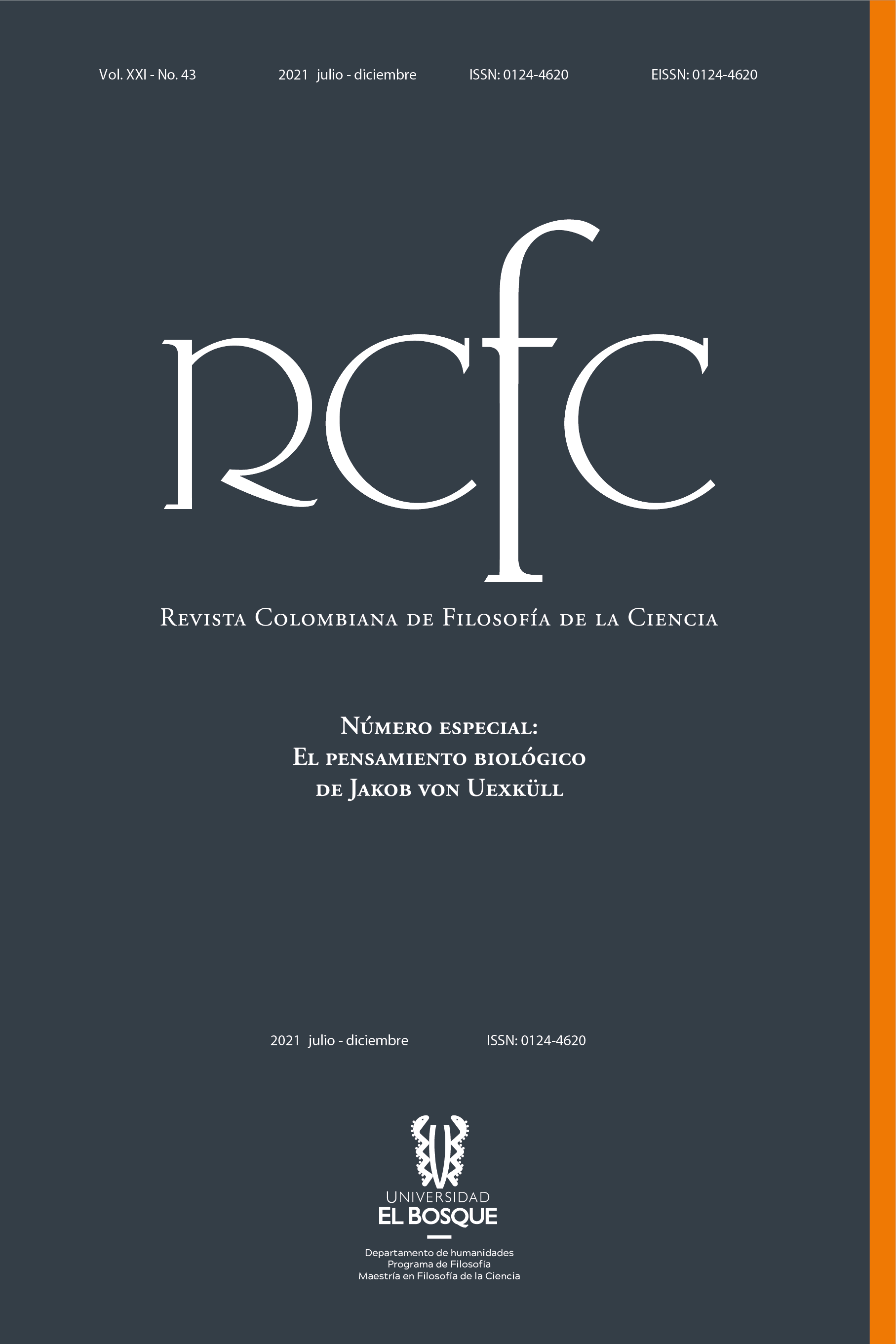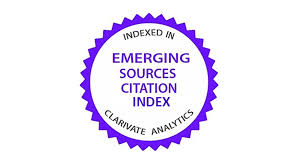Life and Imaginal Texture of the Surrounding World (Umwelt)
Ideas for an Ethological and Cinematographic Realism of the Animal-image
DOI:
https://doi.org/10.18270/rcfc.v43i21.3795Keywords:
Uexküll, Umwelt, surrounding world, ethology, moving image, self, cinema, realismAbstract
The article proposes an interpretation of some aspects of the Umwelt theory formulated by Jacob von Uexküll, in which the possibility of studying what is here called the imaginal texture of the surrounding world of animals, as material that composes their perceptual, affective and motor experiences, is developed. To this end, a realism of images is defended through a dialogue between, on the one hand, the sensory-motor scheme of biosemiotics, the synthesis between physiology and environment of sensory ecology, the Eco Evo Devo approaches and the neurobiological theory of the self presented by Antonio Damasio; and, on the other hand, part of Gilles Deleuze's philosophy of cinema and Gilbert Simondon's philosophy of images. From this point of view, the possibility of an ethology of the animal-image is raised, capable of studying the moving folds of matter under the signs of cinema and biology. Special emphasis is placed on the problem of zoological subjectivity as a biological image, through a critique of the animal subject in Uexküll, with a Kantian root. Just as Uexküll proposed a musical image of nature that opened his understanding for the study of animal behavior, this article aims to develop another type of aesthetic potencies that are inherent to his thought, in order to deploy a cinematographic image of nature that accounts for the ethological and ontological status of the living-images that are organisms themselves
Downloads
References
Alvarado Castillo, Nicolás, Arias Herrea, Juan Carlos, & Arcila Rodríguez, Santiago. (n.d.). La individuación de la imagen animal: hacia una etología cinematográfica. Pontificia Universidad Javeriana, 2018.
Arcila Rodríguez, Santiago. “Mundos animales: tejidos de afectos, signos y movimientos”. El Astrolabio 17.2 (2018): 16-28. <https://www.researchgate.net/publication/336589374_Mundos_animales_tejidos_de_afectos_signos_y_movimientos>
Bailly, Jean C. El animal como pensamiento. Santiago de Chile: Metales Pesados, 2014.
Bergson, Henri. Materia Y Memoria: Ensayo Sobre La Relación Del Cuerpo Con El Espíritu. Buenos Aires: Cactus, 2010.
Borghi, Simone. La casa y el cosmos: el ritornelo y la música en el pensamiento de Deleuze y Guattari. Buenos Aires, Argentina: Cactus, 2014.
Brigante, A. M. et ál. El cuerpo, fabrica del yo: Producción de subjetividad en el arte de Luis Caballero y Lorenzo Jaramillo. Bogotá, Colombia: Editorial Pontifica Universidad Javeriana, 2005.
Buchanan, Brett. Onto-ethologies: The Animal Environments of Uexküll, Heidegger, Merleau-ponty, and Deleuze. New York: State Univ of New York Press, 2008.
Damasio, Antonio R. Sentir lo que sucede: cuerpo y emoción en la fábrica de la consciencia. Santiago de Chile: Editorial Andrés Bello, 2000.
_______. En busca de Spinoza: neurobiología de la emoción y los sentimientos. Barcelona, España: Ediciones Destino, 2007.
_______. Y el cerebro creó al hombre: ¿cómo pudo el cerebro generar emociones, sentimientos, ideas y el yo? Barcelona, España: Ediciones Destino, 2012.
_______. El error de Descartes: la emoción, la razón y el cerebro humano. Barcelona, España: Ediciones Destino, 2013.
_______. El Extraño Orden De Las Cosas: La Vida, Los Sentimientos Y La Creación De Las Culturas. Barcelona: Destino, 2018.
Deleuze, Gilles. La Imagen-Tiempo: Estudios Sobre Cine 2. Buenos Aires: Paidós, 2005a.
_______. Derrames: entre el capitalismo y la esquizofrenia. Buenos Aires, Argentina: Editorial Cactus, 2005b.
_______. Spinoza: filosofía práctica. Barcelona, España: Tusquets Editores, 2009.
_______. El pliegue: Leibniz y el barroco. Barcelona: Paidós, 2012.
_______. La imagen-movimiento: estudios sobre cine 1. Barcelona, España: Paidós, 2015.
Deleuze, Gilles., y Guattari, Félix. Mil mesetas: capitalismo y esquizofrenia. Valencia, España: Pre-Textos, 2015.
______. El Antiedipo: capitalismo y esquizofrenia. Barcelona, España: Paidós, 2016.
Deleuze Gilles, David Lapujade, y José L. P. Pardo. Dos regimenes de locos: textos y entrevistas. S.l. Pre-Textos, 2007.
Despret, Vinciane. ¿Qué dirían los animales …si les hiciéramos las preguntas correctas? Buenos Aires, Argentina: Editorial Cactus, 2018.
Fanjul de Moles, María L. Neurobiología Ecológica. México: Siglo Veintiuno Editores, 2013.
Gilbert, Scott F., Bosch Thomas C., y Ledon-Rettig, Cristina. “Eco-Evo-Devo: Developmental Symbiosis and Developmental Plasticity as Evolutionary Agents”. Nature Reviews Genetics 16.10 (2015): 611-22. <https://doi.org/10.1038/nrg3982>
Godfrey-Smith, Peter. Metazoa. Animal Minds and the Birth of Consciusness. London: William Collins, 2020.
Haraway, Donna. Seguir Con El Problema: Generar Parentesco En Chthuluceno. Bilbao: Consonni, 2020.
Heredia, Juan Manuel. “Deleuze, von Uexküll y «la naturaleza como música»”. A Parte Rei Revista de Filosofía 75. (2011): 1-8. <http://dialnet.unirioja.es/servlet/oaiart?codigo=3645624>
Hume, David. Investigación sobre el conocimiento humano. Madrid: Alianza Editorial, 2015.
Jablonka, Eva., Lamb, Marion J. y Zeligowski, Ana. Evolución en cuatro dimensiones: genética, epigenética, comportamientos y variación simbólica en la historia de la vida. Buenos Aires, Argentina: Capital Intelectual, 2014.
Latour, Bruno. Cogitamus: seis cartas sobre las humanidades científicas. Buenos Aires, Argentina: Paidós, 2012.
_______. Cara a cara con el plantea. Una nueva Mirada sobre el cambio climático alejada de las posiciones apocalípticas. Buenos Aires: Siglo XXI editores, 2017.
Leibniz, Gottfried. Monadologia. España: Orbis, 1983.
Michaux, Henri. Las grandes pruebas del espíritu y las innumerables pequeñas. Barcelona, España: Tusquets Editores, 2000.
Sauvagnargues, Anne. Deleuze: del animal al arte. Buenos Aires, Argentina: Amorrortu, 2006
______. Artmachines: Deleuze, Guattari, Simondon. Edinburgh: Edinburgh University Press, 2016.
Simondon, Gilbert. Imaginación e invención. Buenos Aires, Argentina: Editorial Cactus, 2013.
______.La Individuación a La Luz De Las Nociones De Forma Y De Información. Buenos Aires, Argentina: Cactus, 2015.
Stengers, Isabelle. Pensar con Whithead. Una creación de conceptos libre y salvaje. Buenos Aires, Argentina: Editorial Cactus, 2020.
Stjernfelt, Frederik. “Tractatus Hoffmeyerensis: Biosemiotics as expressed in 22 basic hypotheses”. Sign Systems Studies 30.1 (2002): 337-345. <https://doi.org/10.12697/SSS.2002.30.1.22>
Tamayo, Lukas. “Ontogenia Y Fisionomía Del Paisaje Epigenético: Un Modelo General Para Explicar Sistemas En Desarrollo”. Acta Biológica colombiana 18.1 (2013): 3-18. <https://xurl.es/wd87c>
Uexküll, Jacob von. Cartas biológicas a una dama. Buenos Aires, Argentina: Editorial Cactus, 2014.
_____. Andanzas por los mundos circundantes de animales y hombres. Buenos Aires, Argentina: Editorial Cactus, 2016.
Vinciguerra, Lorenzo. La semiótica de Spinoza. Buenos Aires, Argentina: Editorial Cactus, 2020.
Downloads
Published
How to Cite
Issue
Section
License

This work is licensed under a Creative Commons Attribution-NonCommercial-NoDerivatives 4.0 International License.

| Article metrics | |
|---|---|
| Abstract views | |
| Galley vies | |
| PDF Views | |
| HTML views | |
| Other views | |











